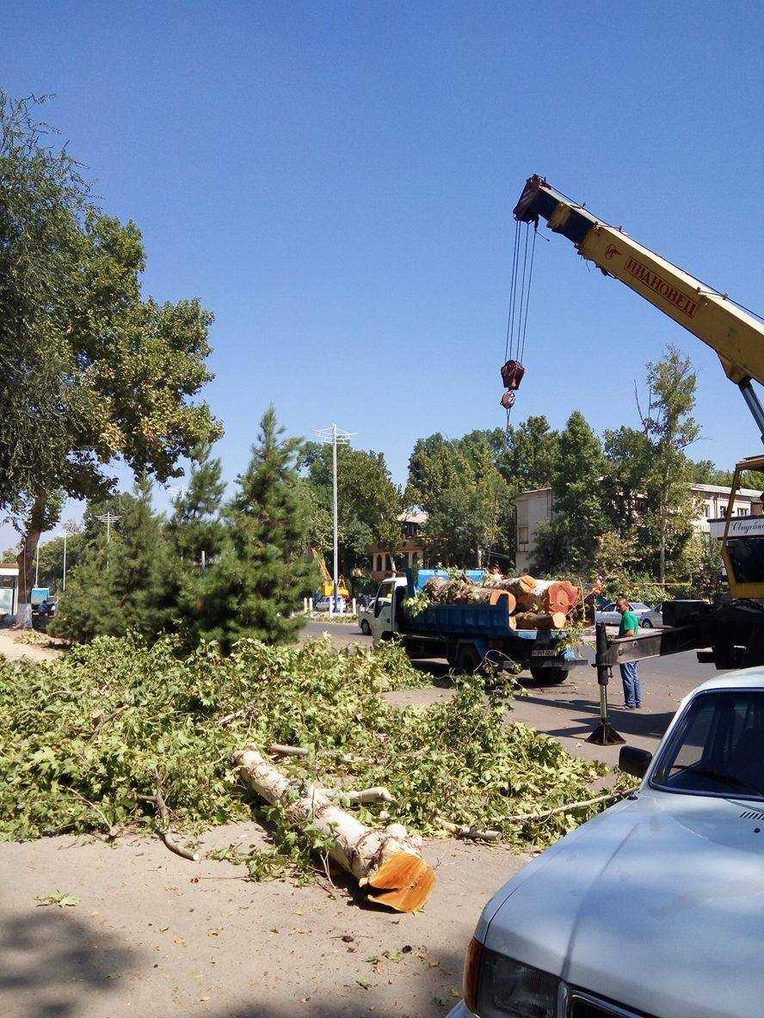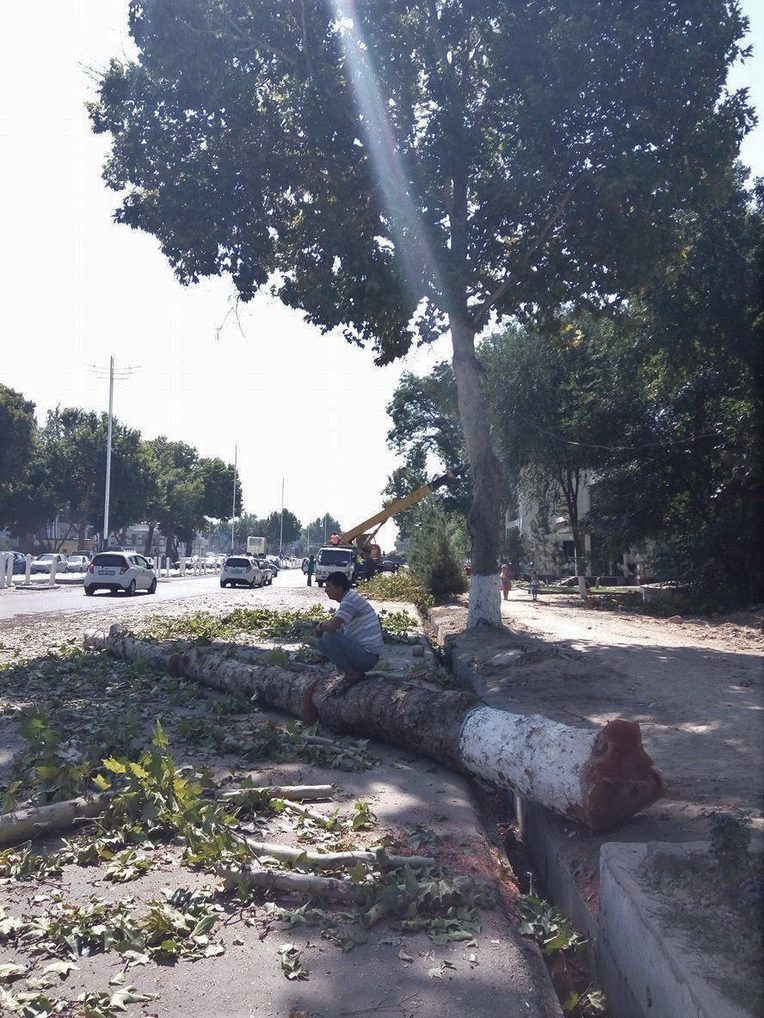Urbane Ruins: Of Tashkent’s Trees, Old-Timers, and Newcomers
From the Series: Green Capitalism and Its Others
From the Series: Green Capitalism and Its Others

At a time when urban greening and the large-scale planting of trees have been universally accepted as a relatively affordable and effective strategy to reduce carbon dioxide levels, improve air quality, and regulate temperature in cities across the globe, in Tashkent, the capital of Uzbekistan, dozens of large deciduous trees are felled annually. Similar phenomena have been observed throughout urban post-Soviet Central Asia, where the dissolution of the Soviet Union and the transition of its successor states to market economy came hand in hand with de-greening, fueled predominantly by indirect forces such as privatization and commodification of urban land and property. Yet, Tashkent’s deforestation has been accelerated by the direct targeting of deciduous trees, the majority of which are felled by the authorities in an attempt to rewrite Tashkent’s history by eliminating parts of the city symbolically associated with its Russian heritage. Additionally, a substantial number are poached by individuals who, often facilitated by state officials, harvest the trees’ wood in order to provide the local furniture industry with raw material. Such a practice is very telling not only of the effects of neoliberal capitalism on urban natures, but also of the workings of the aggressive, anti-social capitalism that drives economic growth in the post-Soviet “Wild East.”
Indeed, the Soviet Union’s dissolution led to a steep fall in the volume of wood that independent Uzbekistan could import from abroad, which, combined with the country’s limited domestic wood production, resulted in a scarcity of high-quality hardwood. This development significantly hindered the operations of the local furniture industry and rendered it unable to meet the increasing demand prompted by the relative improvement of living standards and the emergence of an upper middle class. The opportunity to raise output by using wood harvested from urban trees first emerged in 2009, when Tashkent authorities ordered the felling of the dozens of century-old oriental plane trees (Platanus orientalis) that had been growing on one of the city’s central squares since its incorporation into the Russian Empire in the nineteenth century. As my research has suggested, the bulk of the trees felled then ended up in Tashkent’s furniture workshops and so did most of the wood harvested in the following years and, most notably, in 2016, when the seasonal sanitary pruning of trees turned into a massive deforestation of the city. This abundance of wood contributed to the furniture industry’s remarkable growth in recent years and instigated some workshops to dispatch poachers to illegally fell trees within courtyards, school yards, and even cemeteries in order to ensure their undisrupted access to wood.
Yet, the scale of the deforestation led to the unprecedented mobilization of Tashkent’s multi-ethnic Russian-speaking old-timers, who started confronting loggers—authorized and unauthorized alike—in order to halt the trees’ destruction, due to both their appreciation of the trees’ aesthetic and functional value and the embeddedness of trees in their everyday urban lives and practices. It, thus, came as a surprise to my Russian-speaking interlocutors that many Uzbek-speaking rural newcomers not only did not participate in this mobilization, but, on the contrary, supported—or even actively partook in—tree felling. Indeed, many newcomers see trees as a nuisance because trees accumulate dust, block window views, trigger allergies, and take up valuable parking space, which suggests that, for these individuals, felling is a positive outcome that can potentially improve their everyday urban life. These differences in the way in which Russian speakers and Uzbek speakers approach trees aggravated the pre-existing rivalry between them—driven by the urbanites’ perception of newcomers as primitive, uncultured, uneducated, and unfit to live in a modern urban environment—and revealed that, in a country partly covered by desert, urbanites see trees as a synecdoche for urbanity. Accordingly, the newcomers’ predisposition against trees has been attributed to their origins in the near tree-less provinces, as opposed to the ecological concern of old-timers, which has been received as a product of their autochthony to what had once been the Soviet Union’s greenest city.
As a result, old-timers begun to refer to newcomers, among other derogatory epithets, as mankurty, a literary reference to the work of Kyrgyz writer Chingiz Aitmatov (1984), whose novel The Day Lasts More than a Hundred Years tells the story of a group of men who, upon being taken prisoners by a tribe of cruel warriors, became soulless creatures unable to remember anything from their previous lives. This colloquial attribution of one’s sentiments toward trees to memory is, interestingly enough, in line with academic literature in environmental psychology and especially the work of Rachel Kaplan and Stephen Kaplan (1989), who have argued that people who do not experience “nature” early in their lives regularly are less likely to care about and take care of greenery. Thus, what old-timers refer to as mankurtizm has many similarities with “environmental generational amnesia,” a concept introduced by Peter H. Kahn (2002, 106), who has suggested that
we all take the natural environment we encounter during childhood as the norm against which we measure environmental degradation later in our lives. With each ensuing generation, the amount of environmental degradation increases, but each generation in its youth takes that degraded condition as the nondegraded condition—as the normal experience.
Once we replace Kahn’s focus on time and generational changes with a focus on space and spatial mobility, it becomes evident that for the newcomers who have been born and brought up in the provinces, the “normal experience” is their native near-treeless environment. Following environmental psychologists, then, one could argue that it is their lack of “social-ecological memory” (Barthel, Folke, and Colding 2010) that makes newcomers incapable of developing sentimental ties towards greenery, as opposed to old-timers, for whom the possession of this type of memory makes Tashkent’s ecological “ruination” (Navaro-Yashin 2009) a particularly hurtful experience. Yet, attributing the newcomers’ stance towards trees to the fact that they do not have a personal history of interaction with trees and that trees do not constitute part of their collective environmental memory does not account for the different varieties of environmentalism (Guha and Martínez Alier 1997) and sociocultural conditions that inform what “nature” means to different people. Rather, it puts the blame for the transformation of Tashkent’s urban natures onto newcomers, solely because their understanding of how “nature” should be treated does not comply with the old-timers’ Global North–centric understanding of environmentalism. The ecological othering of newcomers, thus, becomes a rearticulation of habitus, urbaneness, and class, even if in popular discourse it has been attributed to memory, all of which is just an example of how green guilting today finds its others across older forms of distinction.


Aitmatov, Chingiz. 1984. The Day Lasts More than a Hundred Years. Translated by F. J. French. London: Futura.
Barthel, Stephan, Carl Folke, and Johan Colding. 2010. “Social-Ecological Memory in Urban Gardens—Retaining the Capacity for Management of Ecosystem Services.” Global Environmental Change20, no. 2: 255–65.
Guha, Ramachandra, and Joan Martínez Alier. 1997. Varieties of Environmentalism: Essays North and South. London: Earthscan.
Kahn, P. H., Jr. 2002. “Children’s Affiliations with Nature: Structure, Development, and the Problem of Environmental Generational Amnesia.” In Children and Nature: Psychological, Sociocultural, and Evolutionary Investigations, by Peter H. Kahn, Jr. and Stephen R. Kellert, 93–116. Cambridge, Mass.: MIT Press.
Kaplan, Rachel, and Stephen Kaplan. 1989. The Experience of Nature: A Psychological Perspective. Cambridge, UK: Cambridge University Press.
Navaro-Yashin, Yael. 2009. “Affective Spaces, Melancholic Objects: Ruination and the Production of Anthropological Knowledge.” Journal of the Royal Anthropological Institute 15, no. 1: 1–18.